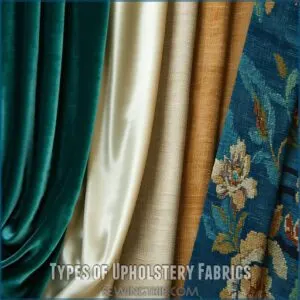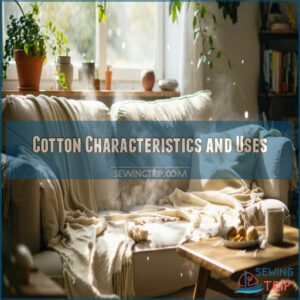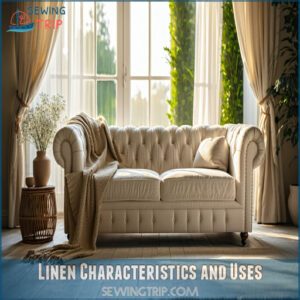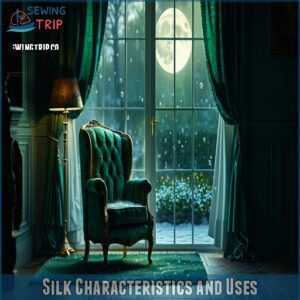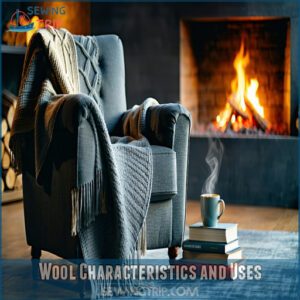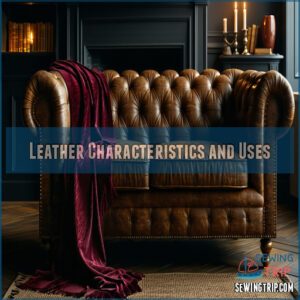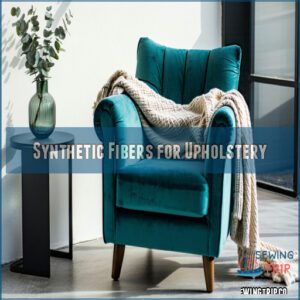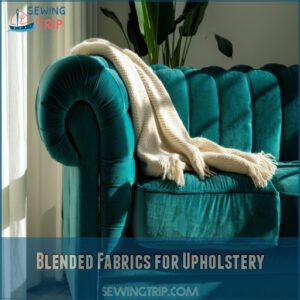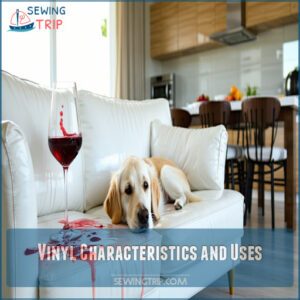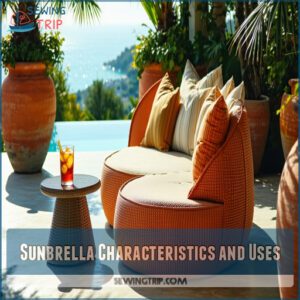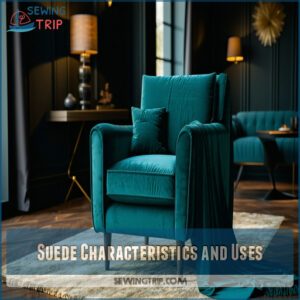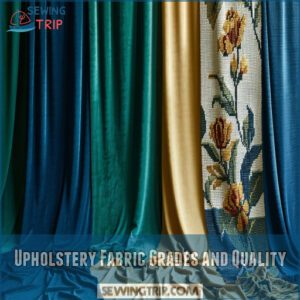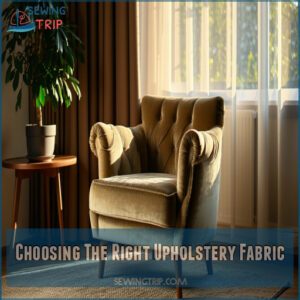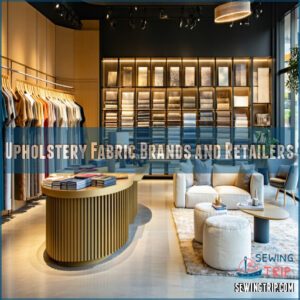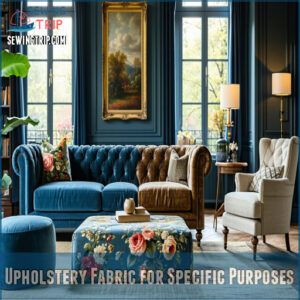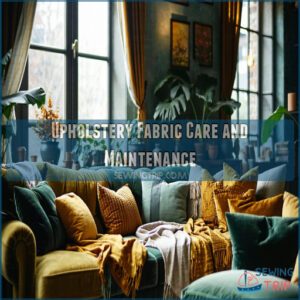This site is supported by our readers. We may earn a commission, at no cost to you, if you purchase through links.
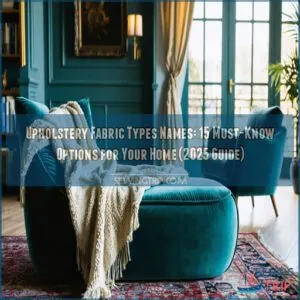 Looking for upholstery fabric types names? You’ve got plenty to choose from!
Looking for upholstery fabric types names? You’ve got plenty to choose from!
Natural fibers like cotton, linen, silk, and wool offer a mix of breathability, softness, and style.
For something sturdier, synthetics like polyester, microfiber, nylon, and olefin are durable, easy to clean, and budget-friendly.
Blends, such as poly-cotton or cotton-linen, balance comfort with toughness.
Specialty options like leather, vinyl, Sunbrella, and suede are perfect for unique needs, from luxury vibes to weather resistance.
Each fabric has its charm, so it’s all about finding what fits your space and lifestyle best, and getting the perfect pick.
Let’s explore further!
Table Of Contents
- Key Takeaways
- Types of Upholstery Fabrics
- Natural Fibers for Upholstery
- Synthetic Fibers for Upholstery
- Blended Fabrics for Upholstery
- Specialty Upholstery Fabrics
- Upholstery Fabric Grades and Quality
- Choosing The Right Upholstery Fabric
- Upholstery Fabric Brands and Retailers
- Upholstery Fabric for Specific Purposes
- Upholstery Fabric Care and Maintenance
- Frequently Asked Questions (FAQs)
- Conclusion
Key Takeaways
- You’ve got natural options like cotton, linen, silk, and wool for breathability, comfort, and timeless appeal.
- Synthetic fabrics like polyester, microfiber, and nylon are durable, stain-resistant, and budget-friendly.
- Blended fabrics, like cotton-linen or poly-cotton, mix natural comfort with synthetic toughness.
- Specialty choices like leather, vinyl, and Sunbrella are great for luxury, durability, or outdoor needs.
Types of Upholstery Fabrics
You’ll find three main types of upholstery fabrics for your furniture: natural fibers like cotton and wool, synthetic materials like polyester and nylon, and blended fabrics that combine the best of both worlds.
Whether you’re reupholstering your favorite armchair or shopping for a new sofa, understanding these fabric options will help you pick the perfect material that matches your style and lifestyle needs.
Natural Fibers Overview
While exploring natural fabric options for your furniture, you’ll discover a delightful range of materials that bring unique character to your home.
Cotton fabric offers exceptional breathability and durability, while linen fabric adds timeless elegance.
Silk fabric creates luxury with its distinctive sheen, and wool fabric provides natural warmth and stain resistance.
Even jute fibers bring an eco-friendly touch, making natural upholstery choices both sustainable and stylish.
Synthetic Fibers Overview
Beyond natural fibers, you’ll find synthetic materials taking center stage in modern upholstery.
Thanks to fiber technology advances, options like polyester, nylon, and microfiber offer impressive durability at budget-friendly prices.
These engineered fabrics resist stains and fading while providing comfort you can count on.
From acrylic’s wool-like softness to olefin’s tough-as-nails performance, synthetic fibers deliver practical solutions for your furniture needs, offering impressive durability.
Blended Fibers Overview
Explore the field of fabric blends, where textile science meets comfort in your living room.
Modern fiber mix technologies create super-powered upholstery that works harder for you. An in-depth fabric guide for upholstery projects offers valuable insights into selecting the right materials.
Consider these game-changing polycotton blends:
- Cotton-linen blends add breathability to durability
- Polyester upholstery brings stain resistance to softness
- Synthetic fibers boost material properties while keeping costs down
You’ll love how these weave patterns combine the best of both worlds – natural comfort with artificial toughness.
Natural Fibers for Upholstery
In the context of upholstery, natural fibers like cotton, linen, wool, and silk bring comfort, durability, and timeless appeal.
These materials offer breathability and a cozy feel, making them perfect for everyday use and elegant spaces alike, which contributes to their timeless appeal.
Cotton Characteristics and Uses
Cotton upholstery shines for its breathability factors and timeless comfort, making it one of the most popular natural fibers.
Its durability guarantees it holds up well in high-traffic areas, while affordability makes it fit almost any budget.
Cotton care is simple—though it’s prone to staining, regular spot cleaning can keep it fresh.
For added strength, consider a cotton blend or cotton linen blend for your furniture.
Linen Characteristics and Uses
Linen is a classic pick that combines style and strength, making it a favorite among upholstery fabric types.
Its natural breathability and textile strength mean it stays cool, crisp, and tough against daily use. Linen’s superior breathability and moisture-wicking make it ideal for warm climates. Plus, linen durability is no joke—this fabric ages gracefully.
You can compare linen’s characteristics to cotton for a deeper understanding of its benefits.
- Strong weave resists pilling and fading.
- Eco-friendly choice, thanks to its sustainable production.
- Timeless elegance that fits formal and casual spaces.
- Refined textures elevate furniture effortlessly.
As lovely as it’s sturdy, linen upholstery truly represents the best of natural upholstery fabrics.
Silk Characteristics and Uses
Silk upholstery adds elegance, with its radiant sheen and refined texture. It’s a luxury fabric best for low-traffic areas.
Despite the beauty, silk durability is limited; it’s delicate and needs gentle care, like professional cleaning.
Here’s a quick glance:
| Feature | Benefits | Challenges | Ideal Use |
|---|---|---|---|
| Silk Weave | Smooth, shiny finish | Can snag easily | Accent chairs, headboards |
| Luxury Fabric | High-end aesthetics | Costly | Statement pieces |
| Natural Fabric | Breathable, elegant | Not stain-resistant | Formal spaces |
| Silk Care | Dry-cleaning required | Prone to damage | Homes without pets/kids |
Wool Characteristics and Uses
Wool upholstery is a rockstar among natural upholstery fabrics, offering durability, comfort, and timeless charm.
It’s perfect for cozy furniture, thanks to its natural insulation and soft textures. Plus, wool resists pilling and stains, making it a low-maintenance choice.
- Fire-safe materials for added peace of mind
- Eco-friendly and sustainable fiber blends
- Strong durability, ideal for everyday use
Explore wool types fabric for practical yet luxurious upholstery fabric types.
Leather Characteristics and Uses
Leather upholstery is a timeless pick that blends durability, sophistication, and practicality.
It’s perfect for everything from classic living rooms to modern spaces, but understanding leather types is key.
| Here’s a quick guide: | Leather Type | Durability | Best Use |
|---|---|---|---|
| Full-Grain | Excellent | High-end furniture | |
| Top-Grain | Very Good | Daily-use sofas | |
| Bonded Leather | Fair | Budget-friendly decor |
Leather’s durability and natural elegance make it a standout material.
While genuine leather lasts decades with proper leather care, options like artificial leather offer affordable alternatives.
Choose wisely based on your lifestyle and room needs!
Synthetic Fibers for Upholstery
You’ll love synthetic fibers for upholstery if you want something durable and low-maintenance. They’re tough, stain-resistant, and come in a range of styles to suit any room.
Polyester Characteristics and Uses
Polyester’s no pushover.
It’s one of the upholstery fabric types that pairs amazing durability with effortless upkeep.
Wrinkle-resistant and fade-resistant, this synthetic material is a multitasker and works well solo or in blends.
Whether it’s for high-traffic furniture or stylish accents, polyester upholstery delivers.
Its advanced fabric weaving and textile science guarantee a tough, reliable choice without losing looks.
Nylon Characteristics and Uses
When discussing nylon fabric, you’re looking at one of the toughest upholstery fabric types out there.
Its abrasion resistance makes it a champion for high-traffic spaces like living rooms or play areas.
As a synthetic material, nylon upholstery offers durability, mold resistance, and longevity.
Plus, nylon blends add flexibility, balancing strength with style.
Whether you need a sofa that can handle pets or chairs that put up with constant use, nylon upholstery is your go-to for practical, modern furniture solutions.
Acrylic Characteristics and Uses
Acrylic upholstery fabric is a synthetic fabric that checks all the right boxes for furniture. It’s durable, fade-resistant, and keeps its vibrant look for years.
The soft textures and acrylic weave upholstery fabric create a cozy feel while staying budget-friendly.
- Fade Resistance: Perfect for sun-filled rooms.
- Color Retention: Keeps furniture looking fresh.
- Synthetic Blends: Adds strength without losing softness.
- Low Maintenance: Dirt and wrinkles don’t stand a chance.
An excellent pick for high-traffic spaces.
When considering synthetic fibers, understanding material comparisons is essential for making informed decisions.
Olefin Characteristics and Uses
Olefin fabric is a game-changer for upholstery.
This synthetic fabric boasts impressive durability and water resistance, making it perfect for both indoor and outdoor use.
Its lightweight nature and excellent moisture-proofing keep it in top shape, even in tough weather.
Olefin upholstery is also budget-friendly and a breeze to maintain.
With its synthetic strength and chemical-resistant properties, it’s a practical choice for anyone exploring upholstery fabric types for lasting versatility.
Reliable and affordable, olefin fabric delivers unmatched value.
Microfiber Characteristics and Uses
Microfiber upholstery is one of the most popular synthetic fabric choices.
Its soft texture feels cozy, yet it’s known for durability and stain resistance. Cleaning’s a breeze – spills? Just wipe them off!
You’ll find microfiber fabric perfect for sofas or high-traffic areas.
- Why it works:
- Long-lasting Microfiber Durability.
- Easy Cleaning for busy homes.
- Affordable yet stylish upholstery fabric types.
Blended Fabrics for Upholstery
Blended fabrics bring the best of both worlds, combining natural and synthetic fibers for durability and comfort.
They’re versatile, cost-effective, and great for handling everyday wear while keeping your furniture stylish.
Poly-Cotton Blends Characteristics and Uses
When you’re looking for a mix of comfort and resilience, poly-cotton blends hit the sweet spot.
These fabric blends combine cotton’s natural softness with the durability of polyester fabric, making them perfect for high-traffic areas.
Polycotton offers standout fabric durability, resists wrinkles, and handles daily use.
With versatile weave styles and clear care instructions, it’s a practical, budget-friendly choice.
Cotton-Linen Blends Characteristics and Uses
Cotton-linen blends are the best of both worlds, combining cotton’s softness with linen’s crisp charm.
These breathable fabrics are perfect for warm climates and look gorgeous even with daily use. Linen’s superior breathability characteristics make it ideal for warm weather.
These eco-friendly, natural blends also bring durability and elegance to any space.
Here’s why you’ll love them:
- Fabric Durability: Long-lasting for busy homes.
- Natural Feel: Perfect balance of cozy and stylish.
- Low Maintenance: Fewer wrinkles than pure linen.
- Versatility: Matches various upholstery fabric types effortlessly.
Tips for Choosing Blended Fabrics
Choosing blended fabrics for your furniture? Here’s how to get it right:
- Assess the fabric ratio for the right mix of comfort and durability.
- Compare blend types like cotton blends or synthetic fabrics for your needs.
- Look into fiber mix durability tests for high-traffic areas.
- Check care instructions for easy maintenance.
- Match fabric grades to your lifestyle and room purpose.
Specialty Upholstery Fabrics
You’ve got plenty of exciting options with specialty upholstery fabrics, from durable vinyl to weatherproof Sunbrella.
Each one offers unique benefits, whether you’re sprucing up outdoor furniture or adding a touch of luxury indoors.
Vinyl Characteristics and Uses
Vinyl upholstery is a game-changer for budget-conscious homes.
It’s durable, low-maintenance, and perfect for busy spaces. Spills? Wipe them away easily.
Need more convincing? Check out this breakdown:
| Vinyl Benefits | Vinyl Applications | Vinyl Costs |
|---|---|---|
| Easy to clean | Dining chairs, sofas | Affordable alternative |
| Moisture-resistant | High-traffic rooms | Cost-effective to leather |
| Long-lasting durability | Kids’ rooms, offices | Wallet-friendly option |
Vinyl’s practicality makes it hard to beat.
Sunbrella Characteristics and Uses
Sunbrella stands out in upholstery fabric types for its unbeatable quality.
It’s your best bet for outdoor upholstery fabrics, thanks to features like weather resistance, fade prevention, and water resistance.
Here’s why homeowners love it:
- Fade-resistant colors that last.
- Water-repellent fabric, perfect for spills.
- Durability tests proven for outdoor use.
- Mold-resistant designs, ideal for tough conditions.
Suede Characteristics and Uses
Suede is a go-to when you want your furniture to exude elegance and a cozy vibe. This luxury fabric stands out with its soft texture and rich appearance, making it a popular choice among upholstery fabric types.
However, it’s like the delicate sibling of leather fabric, demanding extra care. Suede isn’t water-friendly and performs better in low-traffic areas.
- Soft, velvety feel adds warmth to your space
- Creates a stunning velvet alternative for refined decor
- Micro suede options offer a more durable twist
- Best matched with strategic uses, like accent chairs
Think suede, think sophistication!
Upholstery Fabric Grades and Quality
When picking upholstery fabric, it’s important to understand how grades and quality work.
These factors, like thread count and fiber type, help you choose something that looks good and lasts.
Understanding Upholstery Fabric Grades
Think of upholstery fabric grades as your guide to balancing budget and quality.
Grades, often labeled A to F, reflect the fabric grading scale based on fiber type, weave patterns, and durability.
Higher grades mean better materials and construction but also higher costs.
Understanding upholstery fabric grades helps you match performance to your needs.
It’s like choosing a custom suit for your furniture!
Factors Affecting Fabric Quality
Choosing upholstery fabric isn’t just about looks—it’s about quality too.
Five key factors affect upholstery fabric quality and durability:
- Fiber Type: Some fibers resist wear and tear better than others.
- Fabric Weave: Tighter weaves mean more durable fabric.
- Fabric Density: Heavier fabrics tend to last longer.
- Yarn Strength: Stronger yarn means more resilient fabric.
- Manufacturing Precision: Flawless production ensures consistent fabric quality.
These factors safeguard your furniture’s style and longevity, making fabric care simpler.
Thread Count and Its Importance
Thread count plays a key role in fabric durability and quality.
It measures how many threads are woven per square inch, impacting fabric grades, density, and comfort.
Higher thread counts often mean softer upholstery fabric with better fiber strength and weave patterns.
Basic upholstery fabric types use 100-200 thread counts, while premium options range from 300-500 for exceptional fabric durability.
Balance your needs, whether it’s practicality or luxury, using thread quality as your guide to achieve better fiber strength!
Choosing The Right Upholstery Fabric
When you’re picking upholstery fabric, think about how it’ll hold up to your everyday life. Focus on durability, maintenance, and style to match your needs and budget.
Considerations for Fabric Selection
Picking upholstery fabric is like choosing a teammate — balance looks, fabric durability, and how it handles life’s chaos.
Assess color selection, pattern choice, and texture options for comfort and style.
Don’t skip considering budget constraints or fabric grades.
Will it face daily wear or pets?
Understanding your space and needs makes fabric selection a practical process, blending function with beauty.
Durability and Maintenance Factors
To keep your furniture looking great, focus on maintenance and care. The right upholstery fabric can handle spills, wear, and life’s messiness. Poor maintenance? That’s when issues arise.
Choose fabrics known for strength, stain resistance, and minimal color fading.
- Go for tightly woven fabrics—they shrug off wear like a pro.
- Microfiber is a champ for stain resistance, perfect for families.
- Look for high abrasion resistance and better fabric grades to outlast daily use.
Smart upkeep maintains long-lasting style!
Budget and Style Considerations
Don’t sweat balancing Fabric Costs and Style Trends—budget planning makes it simple!
Synthetic upholstery fabrics, like polyester, are budget-friendly and versatile. Microfiber offers modern flair and easy cleaning.
Cotton blends? Classic and cost-effective options. Leather screams luxury but costs more.
Sunbrella fits premium outdoor needs. Match fabric grades to color schemes and Textile Choices for a polished, practical look!
Upholstery Fabric Brands and Retailers
When selecting upholstery fabric, knowing where to shop can make all the difference. You’ll find trusted brands and online retailers offering everything from budget-friendly options to luxurious, high-quality materials.
Top Upholstery Fabric Brands
For upholstery fabric brands, start with tried-and-true names like Waverly, Covington, and Mill Creek—famous for their durability and timeless designs.
For a touch of luxury, explore Hamilton Fabrics or Schumacher, known for high Fabric Quality and elegant styles.
These brands set the bar with thoughtful Material Sourcing, top Manufacturer Rankings, and dazzling options that follow the latest Industry Trends.
Considering the various types of upholstery is essential for making an informed decision when choosing the perfect fabric for your home.
Online Retailers for Upholstery Fabric
If you’re diving into fabric shopping, online stores are a goldmine.
Consider key upholstery fabric factors before purchasing.
Popular upholstery fabric online stores like KOVI Fabrics, Online Fabric Store, and JOANN deliver amazing picks.
Here’s a quick list to streamline your search:
- KOVI Fabrics: Luxurious upholstery grades.
- Online Fabric Store: Wide material range.
- JOANN: Great deals, flexible returns.
- Fabric.com: Trusted digital marketplace.
- Calico Corners: Specialized fabric selection.
Shop smart—check shipping, return policies, and reviews!
Where to Buy Upholstery Fabric
Looking for upholstery fabric? You’ll love these options:
- Visit local fabric stores for hands-on advice and a cozy selection.
- Explore online fabric stores like JOANN or 1502 Fabrics for endless choices.
- Check out discount retailers and wholesale dealers for budget-friendly finds.
From fabric warehouses to upholstery fabric online stores, there’s something perfect for every project and price point!
Upholstery Fabric for Specific Purposes
Choosing the right upholstery fabric depends on how you plan to use it.
Whether it’s for easy cleaning, handling pets, or lasting through daily use, each fabric has its own perks.
Best Fabric for Cleaning and Maintenance
If you want easy-to-clean upholstery, microfiber is a winner. It’s stain-resistant, water-resistant, and handles everyday messes like a pro.
Spills? Wipe them away effortlessly. Explore various microfiber upholstery fabric options for your furniture.
Here’s a quick comparison:
| Feature | Microfiber | Leather | Vinyl | Wool-Cotton Blend |
|---|---|---|---|---|
| Stain Resistance | High | Moderate | High | Moderate |
| Water Resistance | High | Moderate | High | Low |
| Durability | High | Very High | High | High |
| Maintenance | Easy | Easy | Easy | Moderate |
Tip: Stick with microfiber for simple fabric maintenance!
Best Fabric for Dining Room Chairs
Dining room chairs endure spills, crumbs, and constant use, so pick upholstery fabric that matches your lifestyle and dining room style.
Consider browsing a wide selection of dining chair fabric options online. Prioritize stain-resistant fabric or low-maintenance options to keep things stress-free.
- Leather: Elegant, easy to wipe clean.
- Vinyl: Budget-friendly and tough against stains.
- Microfiber: Soft, comfortable, and stain-resistant.
- Performance fabrics: Reliable and built for durability.
These chair fabric options blend durability, seat comfort, and style, perfect for any table setting.
Best Fabric for Durability and Pets
Protecting your furniture from pets is easier with the right fabrics.
Pet-friendly options like leather, canvas, and microfiber offer durable textiles that resist scratches, stains, and stubborn pet hair.
These tough, stain-resistant upholstery fabrics excel in high-traffic areas.
Shoppers can find durable pet-proof upholstery for their homes.
Look for tightly woven, water-resistant upholstery for added durability and easy cleanup.
With these stain-resistant, easy-to-clean upholstery choices, your furniture will handle furry companions effortlessly!
Upholstery Fabric Care and Maintenance
Taking care of your upholstery fabric doesn’t have to be complicated, but it does take a bit of know-how.
With regular cleaning, quick action on spills, and a few smart habits, you can keep your furniture looking great for years to come, which is the ultimate goal of regular cleaning.
Tips for Cleaning and Vacuuming
Keeping your upholstery fresh isn’t rocket science. Follow this simple routine:
- Use a soft brush vacuum attachment for gentle dust removal.
- Sweep seams and crevices thoroughly.
- Create a maintenance schedule to prevent buildup.
- Pick easy cleaning upholstery fabrics for hassle-free care.
- Choose stain-resistant fabric for mess-prone areas—it’s a lifesaver for fabric cleaning and durability!
How to Remove Stains and Spills
Act fast when spills happen! Blot immediately with a white cloth—don’t rub, as it spreads stains.
Tailor cleaners to the fabric: mild soap for cotton, rubbing alcohol for microfiber, and specialized products for leather.
Always test Cleaning Products on hidden spots to make sure they work without damaging the fabric. These upholstery cleaning tips help maintain stain resistant fabric and ensure long-lasting Fabric Protection through effective Spot Cleaning methods.
Preventing Fabric Damage and Wear
Boosting your furniture’s lifespan is simpler than you think with smart care techniques.
Fabric protection goes a long way, and these five moves make all the difference:
- Rotate cushions weekly—less wear and tear, more even comfort.
- Use fabric protector sprays to guard stain-resistant fabric and easy-to-clean fabric.
- Keep pieces out of direct sunlight; UV rays create sneaky damage.
- Vacuum with a soft brush attachment to keep abrasion-resistant fabrics intact.
- Spot-clean spills fast with water-resistant, fabric-friendly cleaners.
These small steps guarantee lasting beauty and fabric longevity, ensuring your furniture remains in great condition with proper care.
Frequently Asked Questions (FAQs)
What are the different types of upholstery fabric?
Did you know cotton is the most popular upholstery fabric?
You’ve got plenty of options: natural fibers like linen, silk, and wool, or durable synthetics like polyester, microfiber, and nylon.
Leather adds timeless elegance too, and with all these choices, you can find the perfect fit for your needs, considering natural fibers as a great alternative.
What kind of upholstery should you choose?
Pick upholstery based on your needs.
For durability, go with microfiber or leather; for comfort, cotton or linen works great.
High-traffic areas? Sturdy fabrics like polyester fit well.
Style matters too—choose patterns or textures you love, considering complete concepts that fit your space.
What are the different upholstery fabric grades?
Upholstery fabric grades depend on durability, fiber type, and weave.
Higher grades offer better thread count and longevity, while lower grades suit budget-friendly options.
Always check the manufacturer’s grading system for quality details.
What are the most popular natural upholstery fabrics?
When considering natural upholstery fabrics, think cotton for comfort, linen for elegance, leather for timeless class, and wool for warmth.
These materials shine in durability, style, and breathability, making them your ultimate cozy upgrade.
How do I choose the best upholstery fabric?
Choosing upholstery fabric? Think function first.
High-traffic spaces need durability like microfiber; for luxury, leather or silk shines.
Don’t skip considering maintenance, kids, and pets. Match style, care needs, and budget—you’ll thank yourself later!
Where can I buy designer upholstery fabric?
You can find designer upholstery fabric at specialty stores like Joann, online retailers like Fabric.com or Etsy, or through interior designers.
For exclusive options, check trade-only suppliers offering samples or swatches.
What are the different grades of upholstery fabric?
One size doesn’t fit all, especially with fabric grades.
They’re rated by durability, weave, and fiber.
Lower grades suit light use; higher ones are tougher for busy spaces.
Check fabric cards for clear comparisons!
Which type of fabric is the most durable for upholstery?
For durability, you can’t go wrong with leather, microfiber, or tightly woven synthetic blends like polyester or nylon.
They resist wear, handle high traffic like a champ, and are easier to clean than most natural fabrics.
What is the most common type of cover for upholstery?
In the context of upholstery, cotton stands out as the top choice.
It’s breathable, comfortable, and versatile, fitting everyday furniture beautifully.
You’ll find it’s widely trusted for its pattern variety and durability, though stains can be tricky.
Which fabric is best for formal upholstery?
For formal upholstery, silk is a top choice.
It adds luxury with its sheen and soft texture.
However, it’s delicate, so consider blends like linen-silk for a mix of elegance, strength, and durability.
Conclusion
Imagine picking a cotton-linen blend for a cozy sofa—it’s stylish, comfy, and durable.
Choosing the right upholstery fabric type doesn’t have to be overwhelming when you know your options. Whether you prefer breathable natural fibers, hardy synthetics, or versatile blends, each has pros and cons.
Think about your lifestyle, pets, or cleaning needs before selecting. With these upholstery fabric types names in mind, you’re ready to find the perfect fabric for any space in your home, considering the perfect fabric!
- https://revolutionfabrics.com/blogs/gotcha-covered/upholstery-fabric-types?srsltid=AfmBOorB1f7fbjuoADHSj7Urc7-v73iXemqnPm34fid6wSuotfW2v3Wv
- https://lorfords.com/blogs/blog/an-introduction-to-upholstery-fabrics
- https://www.textileschool.com/9227/exploring-the-world-of-upholstery-fabrics-types-characteristics-and-choosing-the-right-one/
- https://vevano.com/blogs/furniture/couch-upholstery-material-types?srsltid=AfmBOopjndtFkOS7sVdU-523QLOZCBJIq1RQiKqKjTSlvGNBrB-3W6Qs
- https://alnassaj.com/upholstery-fabrics/

